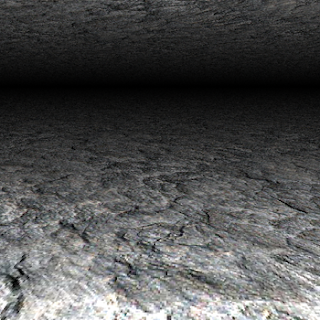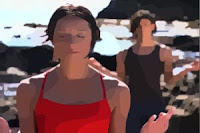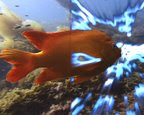 Note to self on perspective: this little psunami video from Japan, if you watch the first 3 minutes only it's like "oh whatever" -- but stick with it. Via @seanbonner, @petebw, etc. Plus, a state of emergency at five nuclear reactors! The Atlantic has pictures of the aftermath. Godzilla is an interesting metaphor, and those mocking Japan now about Pearl Harbor (see Ignorant and Online) aren't immune to natural disasters.
Note to self on perspective: this little psunami video from Japan, if you watch the first 3 minutes only it's like "oh whatever" -- but stick with it. Via @seanbonner, @petebw, etc. Plus, a state of emergency at five nuclear reactors! The Atlantic has pictures of the aftermath. Godzilla is an interesting metaphor, and those mocking Japan now about Pearl Harbor (see Ignorant and Online) aren't immune to natural disasters. March 13, 2011
The Particular After Effects of After Effects
 Note to self on perspective: this little psunami video from Japan, if you watch the first 3 minutes only it's like "oh whatever" -- but stick with it. Via @seanbonner, @petebw, etc. Plus, a state of emergency at five nuclear reactors! The Atlantic has pictures of the aftermath. Godzilla is an interesting metaphor, and those mocking Japan now about Pearl Harbor (see Ignorant and Online) aren't immune to natural disasters.
Note to self on perspective: this little psunami video from Japan, if you watch the first 3 minutes only it's like "oh whatever" -- but stick with it. Via @seanbonner, @petebw, etc. Plus, a state of emergency at five nuclear reactors! The Atlantic has pictures of the aftermath. Godzilla is an interesting metaphor, and those mocking Japan now about Pearl Harbor (see Ignorant and Online) aren't immune to natural disasters. January 25, 2010
Animated Cartoon Arrows
Animated Cartoon Arrows from Brad Chmielewski on Vimeo.
November 2, 2009
Atlas: a new tone mapping filter for After Effects
 Stefan Minning has released a new tone mapping plug-in for After Effects, Atlas. It's a work-in-progress and open-sourced under the free GPL license.
Stefan Minning has released a new tone mapping plug-in for After Effects, Atlas. It's a work-in-progress and open-sourced under the free GPL license.Atlas is Windows-only for now -- but the full source code is included, which means that anyone can compile a Mac version. Here's more from Stefan...
"So what’s tone mapping you ask? According to Wikipedia:
The technique is particularly useful if you have high dynamic range images, such as rendered CG-imagery in floating point color-depth (OpenEXR) or HDR photographs, and you want to bring their broad spectrum into a range more suitable for display on a computer monitor or television screen."Tone mapping is a technique used in image processing and computer graphics to map a set of colours to another; often to approximate the appearance of high dynamic range images in media with a more limited dynamic range.
 Note: Stefan released [umm sorry, teased instead] another filter recently, Edgar, "which is designed to work in combination with Normality and generates squeaky clean cartoon outlines. Edgar uses a novel, proprietary algorithm developed specifically for the purpose of converting normal passes into line art for use in cartoon and anime productions."
Note: Stefan released [umm sorry, teased instead] another filter recently, Edgar, "which is designed to work in combination with Normality and generates squeaky clean cartoon outlines. Edgar uses a novel, proprietary algorithm developed specifically for the purpose of converting normal passes into line art for use in cartoon and anime productions."
July 28, 2009
Word Bubble, Thought Bubble
 Round about the cauldron go... our economic models bubble (ala Orson Welles' Macbeth). But let's not go there now.
Round about the cauldron go... our economic models bubble (ala Orson Welles' Macbeth). But let's not go there now.Digital Anarchy is offering a free filter, Cartoon Bubble for Photoshop and Photoshop Elements, that creates word bubbles. It works nicely in combination with Cartoon filters.
You could also create word bubbles from scratch in After Effects, and Pro Juice has a new tutorial to show you how. In Thought Bubble (After Effects), Nick from Pro Juice uses masking techniques, motion tracking and shadows, to create "a thought bubble that floats alongside Arlo's head helping him decide what to do."

 Note: Pro Juice recently did another tutorial on a more common task in Witness Protection, where they take you through 3 different ways to obscure and render a character unidentifiable in an interview situation.
Note: Pro Juice recently did another tutorial on a more common task in Witness Protection, where they take you through 3 different ways to obscure and render a character unidentifiable in an interview situation.June 24, 2009
Red Giant ToonIt vs. After Effects CS4 Cartoon
And how about a Particle World vs. Particular match? It wouldn't be a contest as much as a light on why Particular has become the favorite AE filter.
March 13, 2009
Cartoonification at Artbeats
 In Cartoonification at Artbeats, Chris & Trish Meyer have tips for getting better results from the "much-loved" cartoon looks plug-ins:
In Cartoonification at Artbeats, Chris & Trish Meyer have tips for getting better results from the "much-loved" cartoon looks plug-ins: "just slapping these plug-ins at their default settings onto any piece of footage rarely gives satisfying results. In this article, we will discuss which clips are better candidates for cartoon treatments, walk through using the Cartoon effect that comes with After Effects CS4, and suggest ways to pre- and post-process the footage to achieve more interesting results.
By the way Version 2 of Red Giant ToonIt will debut at NAB 2009.
January 19, 2009
Scott McCloud on understanding comics
November 2, 2008
New Features in After Effects CS4: Part 4
 Motionworks has another video in its CS4 tour, New Features in After Effects CS4: Part 4,
Motionworks has another video in its CS4 tour, New Features in After Effects CS4: Part 4,CS4 introduces us to 3 new effects: Cartoon, Bilateral Blur and Turbulent Noise. Bilateral Blur and Turbulent Noise are very similar to the existing Smart Blur and Fractal Noise effects. In this tutorial, we’ll take a quick look at these new effects and see what makes them different.
CS4 product trials are almost ready; you can be notified by Adobe when they're ready. The same gotcha for video is that Adobe trial software doesn't contain the license for some codecs.
September 24, 2008
Spilling the beans on Pixel Bender


david van brink comments on the Kevin Goldsmith post Spilling the beans... Pixel Bender in CS4:"Pixel Bender is Adobe’s way of packaging up (essentially) OpenGL Shader Language, for use as effects plugins to their imaging products.
The outcome will be a lot of extremely cool effects plugins. Some of these will be old effects that run much faster, meaning we can use them more freely. Some of these will new effects that would have been prohibitively slow, but are now merely non-realtime."
In CS4 can you share these pieces of code, like the early shaders and filters done for Flash 10 pictured above (from Pixelero and Mr.doob, or even something akin to Fluffy)? I'm not sure, but After Effects is supposed to support the whole set of Pixel Bender functions, while Flash currently supports only a smaller subset, e.g., no GPU acceleration.
As noted earlier today, the Cartoon filter is a Pixel Bender filter, and the other 2 new GPU-accelerated effects, Turbulent Noise and Bilateral Blur, probably are too. And from an old post here, Pixel Bender in action in the Flash beta.
Update: Create Digital Motion (9/25) covers the same ground as this post and attracted clarifying comments by Kevin Goldsmith:
"Pixel Bender runs on the GPU in the Toolkit, in Photoshop and in After Effects. Photoshop’s new pan-rotate-and-zoom of super large images is also using the GPU. Premiere is using GPU acceleration built on AIF technologies, but does not support Pixel Bender filters in CS4.
Flash runs Pixel Bender multi-threaded on the CPU in 10.0
Peter’s original point is absolutely correct. Adobe was already using GPU acceleration before CS4, but in CS4 we’re pushing it even further. We’re also doing a lot of work on scaling for bigger numbers of multiple-cores. Run a complex Pixel Bender filter in FP 10 on an 4 or 8 core system and watch the CPU utilization."
Update 2: Kevin Goldsmith adds more with CPU, GPU, multi-core.
The Cartoon filter story
 On the After Effects List, some of the AE team shared background on the Cartoon filter (see the Chris Meyer highlight movie), which has been been seen as symbolic of a lack of development focus by Adobe HQ.
On the After Effects List, some of the AE team shared background on the Cartoon filter (see the Chris Meyer highlight movie), which has been been seen as symbolic of a lack of development focus by Adobe HQ.Lost in the shuffle is that Cartoon is one of 3 the new GPU-accelerated effects; the others are Turbulent Noise (an improved version of Fractal Noise, but without looping) and Bilateral Blur (like a fast Smart Blur). Anyway here's the story:
Todd Kopriva:
The Cartoon effect was written using the same foundational technology that underlies Pixel Bender. So, rather than thinking about the time spent on the Cartoon effect as being just spent on the Cartoon effect, think of it as time spent by our best people on implementing, testing, and improving a platform on which all sorts of fast and flexible effects are being built.
If you want After Effects to use your GPU effectively and provide an easy way for users to create effects, then you should be happy that time was spent on the Cartoon effect.
Dave Simons:
For the whole back-story, it's what Todd said, plus this detail: Holger Winnemöller was hired into the research group at Adobe after doing his PhD thesis on real-time video abstraction.
Siggraph paper: http://videoabstraction.net/papers/videoabstraction.pdf
Demo movie: http://videoabstraction.net/movie.php?size=large
BTW, the technically superior Red Giant ToonIt costs $379. Upgrade to AE CS4: $299.
July 22, 2008
free again: BCC Rays Cartoon filter
 This time the offer comes from Toolfarm... like last month, Boris FX is offering a free light version of the Rays Cartoon filter from Boris plug-in from Continuum Complete 5, plus a tutorial. Rays Cartoon creates light out of the user-defined "cartoon edges" of an image, which might be faster than using other tricks. BCC Rays Cartoon is available for Adobe CS3, Apple Final Cut Studio 2, and Avid for a limited time.
This time the offer comes from Toolfarm... like last month, Boris FX is offering a free light version of the Rays Cartoon filter from Boris plug-in from Continuum Complete 5, plus a tutorial. Rays Cartoon creates light out of the user-defined "cartoon edges" of an image, which might be faster than using other tricks. BCC Rays Cartoon is available for Adobe CS3, Apple Final Cut Studio 2, and Avid for a limited time.
June 12, 2008
free Rays Cartoon filter from Boris
 Through June, Boris FX is offering a free light version of the Rays Cartoon filter from Boris plug-in from Continuum Complete 5. Rays Cartoon creates light out of the user-defined "cartoon edges" of an image, which might be faster than using Find Edges with other tricks. BCC Rays Cartoon is available for Adobe CS3, Apple Final Cut Studio 2, and Avid until the promotion expires July 1st.
Through June, Boris FX is offering a free light version of the Rays Cartoon filter from Boris plug-in from Continuum Complete 5. Rays Cartoon creates light out of the user-defined "cartoon edges" of an image, which might be faster than using Find Edges with other tricks. BCC Rays Cartoon is available for Adobe CS3, Apple Final Cut Studio 2, and Avid until the promotion expires July 1st.
April 14, 2008
NewBlue Cartoonr filters free
 NewBlue, Inc. is offering a free plug-in, NewBlue Cartoonr, to "toon up" live-action video with a cartoon look. There's versions for many common desktop video apps at the NewBlue Cartoonr page. (via)
NewBlue, Inc. is offering a free plug-in, NewBlue Cartoonr, to "toon up" live-action video with a cartoon look. There's versions for many common desktop video apps at the NewBlue Cartoonr page. (via)
September 18, 2007
AE Primitive with Invigorator
 Many are familiar with Zaxwerks Invigorator from previous bundles with AE, but like me might lose touch with the latest features in what Zax calls Invigorator Pro.
Many are familiar with Zaxwerks Invigorator from previous bundles with AE, but like me might lose touch with the latest features in what Zax calls Invigorator Pro.Invigorator Pro will give you the basic primitives, which are comp camera and comp light aware, and can import 3D models from 3d programs. You can also get visible 3D paths, function curve control, animation assistants and even expression-based control over 3D animations. Warping is done in a separate filter, 3D Warp. Intersections and other AE-specific features might have to wait for the AE team.
The Zaxwerks blog features a number of links tutorials by John Dickinson and Alan Shisko. Here's Zax's rundown of the newer features:
3D Text Creation
3D Primitives
New Import/Export Format
Motion Blur
Tracking AE's 3D Objects
Layer Map Animation
Highlight Mapping
Render Farming
Wireframe and Hidden Line Rendering
Cartoon Coloring
Absolute Coloring
Matte Coloring
Shadow Catcher Rendering
New Swatch Handling
July 20, 2007
Celulight and Floodgate: AE filters
 Stefan Minning has 2 new filters in beta, but for Windows only for now apparently (see CGTalk discussion).
Stefan Minning has 2 new filters in beta, but for Windows only for now apparently (see CGTalk discussion).Celulight is a cel shader and normal map generator for AE, and uses drawn outlines or cels as source files and allows them to be lit in a pseudo 3D environment using AE’s internal lights. Possible styles include: Classic toon shading, Modern 2.5D Toons, and “Kingdom Hearts” Styles.
Floodgate "can be considered an advanced paint bucket or fill tool" which "floods up to 64 distinct areas with up to 8 different colors. Floodgate is squarely aimed at coloring in toon and cel animation and outlines drawings, which is a real pain to do in After Effects without it."
Update: these might be fun with Live Trace versions of video...Aharon Rabinowitz had a video tutorial series on this feature, Converting Video to Cartoon.
Update 2: there's a report in comments here that this filter has problems in AE8.
April 2, 2007
Digital Anarchy's TOON IT
"Digital Anarchy's TOON IT [new filter package]...is a very, very good reason to check out Digital Anarchy at NAB (or at Photoshop World for that matter). Jim Tierney has a couple of tricks up his sleeve: One for Photoshop users and another for After Effects users."
Update: a person in comments finds this filter too slow for real world work and couldn't get a refund even a day after. Hopefully buyers will try the demos before a purchase, and vendors will realize that piracy is very easy. This blog mostly just passes along news so sorry I didn't comment that you can do this sort of thing by hand with multiple layers of posterize filters, blurs, color correction, and mattes. The setup would be much harder than a filter but once you have a formula you like...
April 11, 2005
The Religious Experience of Philip K. Dick
The Religious Experience of Philip K. Dick by R. Crumb is a cartoon version of PKD's "Valis" experience that was published in Weirdo #17 in 1986. See the Wikipedia PKD summary for more.

